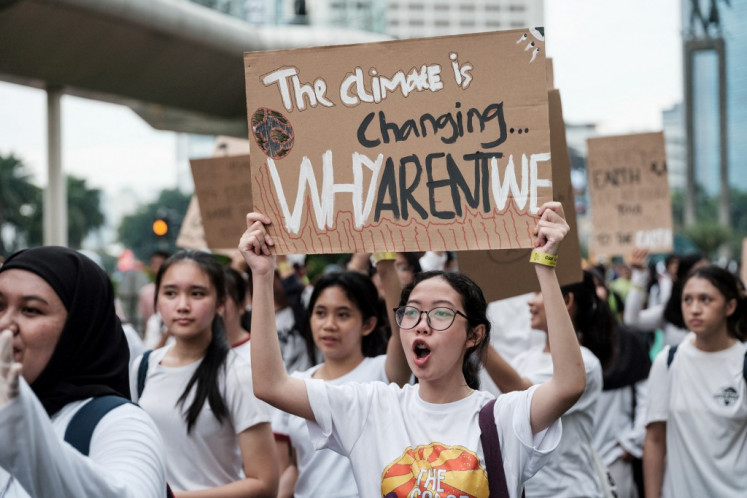Wise pathways for the future of food
It was not too long ago when Marsiana, a farmer from an indigenous community in West Kalimantan, told the story of how she tried to plant new seeds in her field but, against her expectation for a higher yield, the rice crop failed
Change Size

I
t was not too long ago when Marsiana, a farmer from an indigenous community in West Kalimantan, told the story of how she tried to plant new seeds in her field but, against her expectation for a higher yield, the rice crop failed. She then decided to go back to her traditional seed supply to continue to secure future harvests for her family.
This episode is one of many stories in the lives of women farmers in rural Kalimantan who daily and quietly labor in their communities to safeguard local agricultural systems and food security.
By preserving the seeds of the many varieties of rice, sorghum, corn, millet and also tubers and vegetables, and by routinely planting and using them for the consumption of their families and to supply local markets, women farmers remind us of the crucial role that women play in rural economy and the importance of biodiversity for the resilience and sustainability of food crops.
In the words of another woman farmer, Lussia from East Kalimantan, “It is better if we keep a little seed as future reserve than a particular variety gone extinct.”
As we celebrate International Food Day on Oct.16, the day of the founding of the United Nations’ Food and Agriculture Organization (FAO), and strive to achieve a zero-hunger world, special attention to the dimension of biodiversity and the key role of women in rural communities and local food systems is surely merited.
In a world where 70 percent of the world’s poor live in rural areas, and over 40 percent of the workforce in agriculture is women, zero hunger and the achievement of the second Sustainable Development Goal, to “end hunger, achieve food security and improved nutrition and promote sustainable agriculture”, call for the transformation of food production and consumption toward more sustainability and equity.
Vital in this transformation are biodiversity and women.
With increasing land clearing, agribusiness and big food estates, monocropping and heavy chemical input in agriculture, it is not just traditional crops that are being ignored and traditionally used lands encroached upon. It is also the knowledge and traditional ways of growing crops that are under threat, and the local agricultural and food systems that have sustained rural communities for a long time.
Indigenous and local people, for example, have used many agricultural methods that are environmentally sustainable, developing irrigation measures for better use of water, requiring little to no fertilizers or helping replenish the soil naturally.
The strong bond between people and their land and natural resources is central to their food security, livelihoods and cultural identity.
High biodiversity is a salient feature of traditional farming systems (agrobiodiversity) both within a particular crop (e.g., different varieties of rice) or among crops (such as adding other crops to rice fields).
Often these crops are grown in small areas or in very specific micro-climate, and they are not high-yielding varieties in most cases.
These traits, however, can display climate-resistant characteristics and adaptability. Traditional crops have often been kept outside the global markets and distribution.
Agrobiodiversity is an important strategy of risk avoidance. There is also a strong gender component to agrobiodiversity because it is often women who keep and select the seeds and grow native species as additional crops to other household’s crops.
Another important feature of these food systems is their integration in the broader landscapes through the use, often by women, of wild varieties and plants growing in the forest, savannahs, coastal and other areas.
Access to those wild resources is important for the resilience of agrobiodiversity. Moreover, traditional crops can be more nutritious and enrich our diets in healthy ways.
But agrobiodiversity has been eroding and many traditional and indigenous crops have disappeared.
Is talking diversity, locality, old varieties, traditional agricultural at this juncture of time a sign of looking back nostalgically? Or is it instead an indication of alternative and more sustainable ways for the future of food systems and rural economy?
We will need to grow more food for more people on the planet, but this is not enough for zero hunger and sustainability. Safeguarding the environment, maintaining agrobiodiversity, and empowering women are also critically important.
Traditional crops can also have good commercial potential and thus offer good livelihood opportunities for rural communities.
They can support small women’s ventures for the production of local food crops and distribution to urban consumers increasingly keen to buy local, healthy, green and fair products.
There is a growing number of women in rural areas who become entrepreneurs, provide food services, add value to products in the local supply chain, and organize and supply local markets specialized around traditional and organic food crops.
These markets are rooted in their territories and have the potential to support extended networks of producers and consumers who can meet directly, exchange knowledge of the products, diversify diets and sustain or revive the cultivation of traditional food crops.
While there is room to improve production and marketing of traditional crops with technological innovation and investment, supported by stronger consumers’ awareness and call for action, empowering women and safeguarding agrobiodiversity remain core to wise “foodways” for the future.
__________________________
The writer, an anthropologist, is a social development and conservation specialist with WWF Indonesia.









